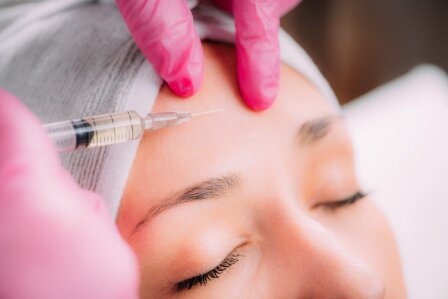

If you want to reduce lines and wrinkles and look younger, you can only get so much from over-the-counter skin care products. That's why many people rely on dermal fillers to turn back the clock.
People considering dermal fillers have many questions, but one of the most significant is which is the longest lasting filler?
As we age, the skin gets thinner and loses elasticity, which leads to lines, wrinkles, and an older appearance of facial skin.
Dermal fillers can help with age-related issues without surgery by smoothing out facial lines and wrinkles. They also restore lost volume and plump the skin to look younger and fresher.
The most popular and effective dermal fillers contain gel-like material that the doctor injects beneath the skin. These products usually contain hyaluronic acid fillers, poly-L-lactic acid, or calcium hydroxylapatite.
The most significant benefit of dermal fillers is reducing aging signs and restoring lost volume without surgery. All you need to do is go to your doctor or surgeon and have them inject the fillers into various parts of the face you want lip fillers to treat, such as the following:
Like other skincare products and procedures, how long dermal fillers last depends on many things. Some dermal fillers fade and can last one or two years, while others last six to 12 months.
The most common fillers use hyaluronic acid, a natural substance in the skin that produces elastin and collagen. These elements give the skin that plump and hydrated look in the younger years.
For a better idea of which other dermal fillers to last the longest, typical longevity for popular dermal fillers are listed below:
Many plastic surgeons say that Juvederm and Restylane are the most durable and longest-lasting fillers available. Both contain hyaluronic acid and are good for smoothing facial wrinkles and lines.
Hyaluronic acid carries 1,000 times its weight in water and makes the skin look young, supple, and soft.
The kind of filler the doctor uses affects longevity, but other factors are also. For example, some parts of the face metabolize the filler faster than others. Also, the mouth area is used a lot, so facial fillers used there may not last as long.
Other factors in filler longevity are how much filler material the doctor uses and how quickly your body metabolizes the product.
After a few months, most fillers begin to degrade, but the effects linger because all fillers absorb water over time. However, by about halfway through the typical longevity of the product, you will see less volume.
Doing a touch-up treatment while the product still has some effect can increase longevity and save money over time.

Choosing the correct dermal filler is something you should discuss with your doctor or surgeon. However, it always is helpful to conduct research and ask informed questions at the consultation.
A key aspect to consider is whether the filler is reversible. While most patients are pleased with the results, it's good to know if the effect can be reversed if you don't like it.
After deciding which filler is best, think about the locations you want to put injectable fillers. Some patients want a subtle improvement, while others want a bolder statement.
For ideal results, work with your doctor or surgeon to figure out the locations in the face where you need the most improvement.
Remember some fillers are better in one part of the face than others, such as below the eyes, while others are ideal severe facial wrinkles or for increasing cheek volume.
Also, remember that even the best dermal fillers are only a temporary treatment, and don't offer a permanent solution to lines, wrinkles, and general facial aging. You will need to think about cosmetic surgery for longer-term results, such as a facelift or brow lift.
Another injectable to consider is Botox, which reduces fine lines and wrinkles by freezing some of the tiny muscles that are used to make common facial expressions.
One of the most attractive aspects of temporary treatment of dermal fillers is there is little recovery. As a result, some patients can have dermal fillers on their lunch break and go back to work.
However, these tips can help improve your dermal filler experience:
Further, you should not engage in vigorous physical exercise for about 24 hours, but going for a walk is fine. It takes a few hours for the filler to settle in, so it's best to avoid vigorous activities that could displace it.
Dermal fillers are often an excellent option to reduce the look of lines and wrinkles while also adding facial volume. Talk to your doctor or surgeon soon to decide which filler is ideal for making you look years younger.
Thinking about dermal fillers in Portland? Dr. Aric Aghayan is proud to serve Portland area patients at his practice, Après Plastic Surgery. He'll go over the options, goals, and more to determine if you're an ideal candidate for dermal filler injections.
How Long Does Filler Last? (2020). Accessed at https://www.healthline.com/health/how-long-does-filler-last
Dermal Filler Overview. (n.d.). Accessed at https://www.fda.gov/medical-devices/aesthetic-cosmetic-devices/dermal-fillers-soft-tissue-fillers
About Dermal Fillers. (n.d.). Accessed at https://www.plasticsurgery.org/cosmetic-procedures/dermal-fillers
Enjoy the pinnacle of cosmetic surgery expertise with board-certified Portland Plastic Surgeon Dr. Aric Aghayan at Après Plastic Surgery. With a legacy of over 1600 successful body contouring procedures, Dr. Aghayan stands as the foremost specialist in advanced body contouring technology and treatment options. Take the next big step on your beauty journey by scheduling a comprehensive plastic surgery consultation with Dr. Aghayan today.